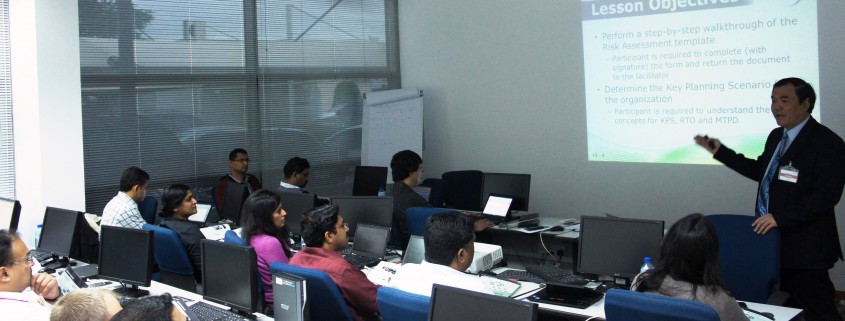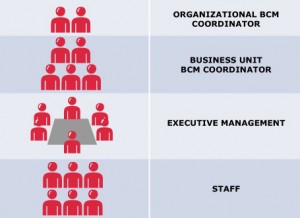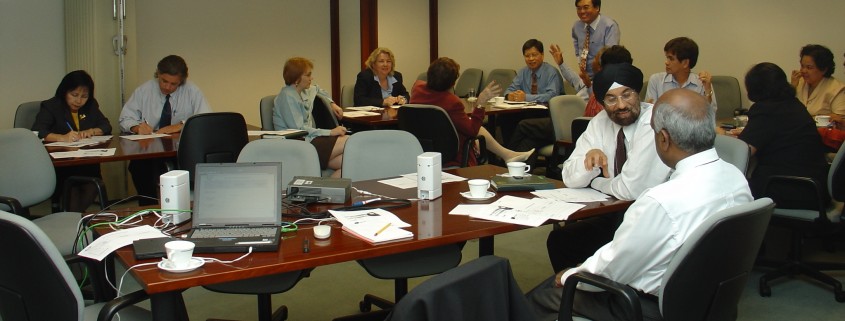Learning Roadmap to Sustain and Upgrade Your Organisational Business Continuity Management Competencies
In today’s workforce, employee engagement, and opportunities for learning and career growth are key determinants of an organisation’s ability to retain staff. A new generation of workers now expect training to be relevant and tailored towards their job needs leading to ever faster career growth; a one size fits all training model simply will not do.
This expectation of delivering relevant, just-in-time training extends to the area of Business continuity management. Business continuity management, or BCM, is a holistic approach in managing crises and disasters that could disrupt an organisation’s operations and potentially cripple its ability to deliver key products and services. As organisations become increasingly aware of the importance of BCM and organisation resilience, the urgent need to provide qualified BCM training , for employees often falls squarely on the shoulders of the Human Resource (HR) management or Learning and Development (L&D) team. This is particularly problematic since BCM is a specialised area of management and training on proper business continuity planning and execution processes is not usually readily available. Moreover it is difficult for HR or L&D to develop a learning framework that addresses diverse BCM learning requirements at different levels of the organisation. For example, a crisis manager (or some time referred to as the Organization BCM Coordinator) responsible for managing a company-wide crisis would probably need to develop a different toolkit of skills as compared to a Business Unit (BU) CM Coordinator focused on recovering only his or her department in a disaster.
To address this situation, BCM Institute has developed a comprehensive Learning Roadmap that helps organisations systematically chart its BCM learning journey. This Roadmap emphasises a 3-year learning cycle providing a full suite of BCM training courses for 4 major stakeholder groups. They are,
- Senior Management
- Organisation BCM Coordinators
- Business Unit BCM Coordinators
- General Staff members
A full spectrum of training ranging from awareness sessions, half-day management briefings, and specialist training programmes at foundation, intermediate, and advanced levels. If desired, participants could earn for themselves internationally recognised BCM certifications by going through an assessment backed by relevant working experience. In introducing this Learning Roadmap to organisations, BCM Institute works with the responsible HR or L&D departments to customise the roadmap to best fit the organisation.
To enhance the learning journey, all trainings are facilitated by senior and experienced BCM industry practitioners who will share best practices and current trends in BCM, and tips on how to best fulfil various roles in planning and executing BCM for the organisation. Participants who opt to join our public courses can look forward to learning from fellow practitioners from different industries on the challenges faced in implementation and how issues were resolved. All certification-level courses are supplemented with an online revision portal allowing for self learning at their own pace.
To know more about the BCM Institute’s Learning Roadmap, please contact sales.sg@bcm-institute.org or call our office at 6748 1528 to obtain a complimentary whitepaper on Organisational Business Continuity Management Learning Roadmap. Visit us at www.bcm-institute.org to see our full range of BCM, disaster recovery, and crisis management courses.
About the Author
Fistri has been a sales and marketing professional for 14 years, spending the last 3 years assisting clients from a whole spectrum of industries in upgrading their Business Continuity, Crisis Management and Disaster Recovery competencies. Fistri is responsible for providing solution to the training and development requirement of clients in ASEAN region. Recently, she was also involved in various crisis simulation exercises and infectious diseases business continuity planning. Fistri is a graduate of Murdoch University with a Bachelor’s in Marketing and hold the Business Continuity Certified Planner (BCCP) certification.
Leading Multilateral Financial Institution Case Study
Leading Asian Multi-lateral Financial Institution
This customer is an international multi-lateral development bank whose mission is to help its developing member countries reduce poverty and improve the quality of life of their people. Headquartered in Manila, and established in 1966, this institution is owned and financed 67 member Asian and global. Its main partners are governments, the private sector, nongovernment organizations, development agencies, community-based organizations, and foundations.
History
This institution is not required to meet any regulatory requirements. However, it is committed to adopting good corporate government policies in line with international best practices, and maintain stakeholders’ confidence. The policies also required it to develop and implement a BCP.
GMH’s Services and Solutions
Although this customer is not bound to comply with any regulatory requirements, it had many key stakeholders. Their BC planning requirements had to take into consideration the multi-facet threats and also address any potential incidents or events that may arise. GMH’s consultants interviewed the Executive and Senior Management teams to ensure the key business objectives, critical business functions and strategy for recovery are addressed when BCP is activated.
Conclusion
This project involved the review of the critical business functions and the identifcation of the recovery strategies. This is concluded with the summary of strategic BC plan implementation of the BCP within the country and also in another location outside of the host country. The business continuity objectives had to be carefully identified and evaluated due to the unique ownership structure of this institution. This was possible as GMH’s BC planning methodology and approach was flexible and adaptable to meet the unique requirements.
Healthcare Services Case Study
Major Healthcare Services Client
Our customer is a leading healthcare services provider in Singapore; operating 9 major clinics sited in strategic locations to make affordable healtcare services easily available to the community. This organization is part of one of the major healthcare service clusters. Their vision is to lead in the field of family medicine using an integrated and holistic healthcare approach. The corresponding mission is to provide patient-centric, preventive and quality healthcare to all patients. The organization is also committed to promoting research, trainng and professional development.
History
Since it is designated by the government as a public healthcare services provider, the organization is considered one of the essential healthcare services provider. This requires the organization to continue to provide healthcare services even during any major incident or crisis. The key challenge was to identify critical operations that will continue functioning when one or more of its sites is affected by a disaster, and/or when there is a national or regional public emergency. In other words, the organization had to develop a BCM framework and implement BC plans that will enable it to continue critical business operations, and integrate their responses and activities with the relevant public authorities and agencies. The customer also required the BCM implementation to be compliant with the TR19:2005 Technical Reference for BCM (now relaunched as SS540 Singapore Standard for BCM in October 2008). Another key requirement was that the approach must be affordable, and does not require too much resources to be committed for too long.
GMH’s Services and Solution
Generally, the 9 clinics are identical in terms of the organization structure and services; with the exception of the corporate office which is co-located with one of the clinics located in the central region. Firstly, an organizational-wide BCM framework was developed and communicated to the BCM steering committee and BCP project team members. Team members came from diverse backgrounds – finance, administration, facilities management, nursing, doctors, corporate and engineering. To establish a common understanding of BCM, its objectives, the planning process, project timeline and key roles and responsibilities, we conducted a 1-day BCM fundamentals training.
Subsequently, the members went through a series of facilitated workshop and consulting sessions to identify the threats and risks, and determine the critical business functions and minimum business continuity objectives. From the information gathered, we designed a BC strategy that required the HQ and clinics to be segmented into clusters of 2 or 3 sites; with each site backing up the other. This ensured that the customer need not establish separate alternate sites to recover critical business functions. The detail BC plans and procedures were then established and tested. The simulation exercise conducted was designed to identify any gaps in the BC plans.
Conclusion
Contrary to common perception that implementing and sustaining BCM is expensive, and requires the commitment of significant amount of resources, this organization benefitted from using GMH’s cost-effective approach to implement an organizational-wide BCM program and plans. Implementation costs were also minimized by establishing other clinics as alternate sites for any affected site. The BCM framework and planning approach also enabled the customer to fulfill its requirement to achieve TR19 certification.
Manufacturing/Service Case Study
Marine Electronics and Office Automation Supplier
This customer started as a sole proprietor in 1976 to supply and service marine electronics equipment. It was then incorporated as a private limited company in 1978. Now it is now a holding company with dealings in properties, marine electronics and office automation. Its philosophy is to innovate, provide leadership and deliver good customer service; with the commitment to maintain social responsibility, human dignity, honesty and integrity.
History
In 2005, the Director and founder of the group, desired to leverage on BCM and the TR19 certification; to enable the organization to become more resilient and benchmark against established international BCM good practices. Being an SME with a workforce of less than 250 staff, the Director stipulated that the BCM program and plan implemented must be sufficiently comprehensive; yet, without causing business costs to increase significantly. Another key constraint was that the project resources and time should be restricted to minimum appropriate levels.
GMH’s Services and Approach
In view of the key project constraints and objectives, GMH deployed a very experienced team with a combined total of about 30 years BC-DR experience. Our consultants conducted the BCM fundamentals training and followed this up with a series of facilitated workshops; which were also complemented with interviews with key stakeholders, department heads and subject matter experts. This enabled the GMH team to identify the threats and risks, and determine the critical busines functions together with the minimum business continuity objectives. This led our consultant to guide the BCP project team to develop the BC strategies and subsequently, detailed recovery procedures. To ascertain the BC plan is effective, GMH conducted an exercise to validate the BC plan against the objectives and strategies.
Conclusion
GMH’s BCM framework and planning process is rigourous, flexible and adaptable to meet different customer’s specific BCM requirements and objectives. Through our framework and approach, this customer implemented a cost-effective BCM solution and program. This enable to the customer to enhance organizational process resiliency. Most importantly, the BCM program and plan implemented is scalable and will ensure that the customer can progressively upgrade its requirements as the organization expands.
Government Agency Case Study
Key Government Agency
This customer is a key government agency tasked to spearhead Singapore’s economic growth and future. Its primary objectives are to attract foreign investments, expand and extend the industries, and help to sustain a pro-business environment.
History
In 2006, this government agency wanted to implement BCM and reinforce its DRP. The scope required BC plans to be developed for its HQ (located in the central business district), local subsidiary offices and its international overseas offices. The scope for testing was limited to the local HQ. But the necessary knowledge and skills to empower the project team members to conduct their own tests for the subsidiaries and overseas, had to be transferred to them.
GMH’s Services and Solution
GMH’s approach was first to conduct the BCM fundamentals training to ensure that the management and project team members have the same common understanding of the scope, definitions and objectives BCM, as well as the BC planning process, and their roles and responsibilities. Identifying the threats and risks for the various locations was more difficult. The relevant project team members had to acquire the necessary skills and knowledge to conduct the risk analysis, with remote support from the GMH team in Singapore. This approach was repeated for each major stage of the BC planning process. The local offices were supported by the GMH team with interviews and face-to-face meetings conducted to complete the information gathering. GMH deployed additional consultants to help the various teams complete the development of the BC strategies. Finally, BC plans were developed for each major site for this agency.
Conclusion
The development and implementation of the BCM frameworka, program and plan for this customer was more complex; as it included overseas offices; this was despite the constraint that the customer required the GMH team to facilitate the BC plan development for the overseas without physically going on-site. The experience and professionalism of our consultants enabled all the key project requirements and constraints to be adhered to, and lead the customer to a successful BCM implementation.
Telecommunications Case Study
Leading Telecommunications Service Provider
This customer is one of Singapore’s leading telecommunications service provider for mobile communications and international call services. It provides customers with coverage and roaming services in more than 200 countries or territories. It was the first an island-wide wireless broadband service in December 2006.
History
This customer required to develop and implement a BC plan that would enable critical business functions to continue to service key customers during a disaster or major incident.
GMH’s Services and Approach
One of the first tasks was to develop the BCM framework and guidelines for the BCP project team. This required the management to define which groups of customers will continue to receive support and customer services. Another key challenge was to identify major single-point-of-failure for the major technology components and infrastructure as part of the risk analysis stage. A key BC strategy the GMH consultants recommended was for the customer to establish another operation center to enhance network operations resiliency; which will work together with the existing operations center. With the help of the GMH consultants, the customer successfully identify the critical business functions and recovery requirements; leading them to implement viable BC plans that were subsequently exercised and maintained.
Conclusion
Implementing BCP for an major technology-based company need to necessarily be always dependent on high-tech solutions. Some of the strategies would require relevant policies and manual interim processes to be executed by the corporate services support divisions during a disaster. Briefly, the BC plan and procedures had to be flexible and adaptable to a wide range of incidents.




